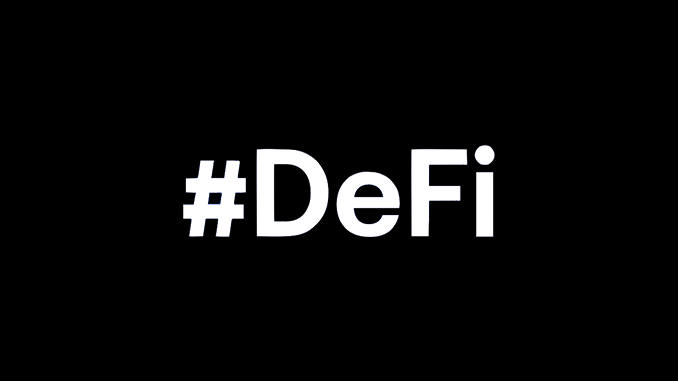
Whether SUSHI or YFI, whether DAI, AAVE or Maker – it is currently so-called DeFi tokens that determine the market and discussion in the crypto industry. Thoughtful tones are mixed into the boom, which question the concept of some shooting stars.
For many years there was a certain basic consensus in large parts of the Kryptoszene: One buys oneself Bitcoin (BTC) or Ethereum (ETH) and makes then – only times nothing. HODL calls itself this behavior and investors feel thereby well, because the completely large times of Bitcoin are to come only still. At the latest then, if central banks must admit the failure of their money pressure policy, the patience with BTC and Ethereum will disburse itself, reads a weighty argument of such Investement strategies. But in the past weeks and months the Kryptobranche experiences new projects, which recruit with DeFi and bring in dream net yields. Does a new era in the world of the Kryptowährungen prepare there and is it time to shift its depot Or is there a lot of fuss about nothing with DeFi and tokens like SUSHI and YFI (yearn.finance) or the decentralized crypto exchange Uniwap?
Pro-arguments for DeFi
Without going into detail: Basically, all currently successful DeFi tokens revolve around loan transactions. They collect liquidity and make it available against interest. They score points – to a greater or lesser extent – because these transactions are organized in a decentralized and automated manner using Smart Contracts and DApps. Fees, which otherwise crypto exchanges or centralized providers can book on the credit side, are marginal with DeFi and are often passed on to investors, as is the case with SUSHI. Uniswap as the central approach place for DeFi reached meanwhile daily volume in the trade, which draw level with the level of Coinbase as largest US crypto stock exchange.
If you look at individual tokens such as Maker (MKR), DAI or Compound (COMP), you will also recognize the concept of decentralized loan transactions. Further developments such as YFI (yearn.finance) drive the business with interest rates to the extreme by constantly moving inserted capital back and forth in an effort to take best interest rates on the market and thus make investors happy.
From this perspective, DeFi is therefore the solution to save fees and to make the centralized providers in the crypto industry lose their business model. “We get back what belongs to us”, the motto can be summarized – and is no utopia. But it also requires active tracking of market movements and could be compared to constantly shifting Fiat from one overnight money account to another in the hunt for the best conditions.
Con-arguments against DeFi
Not only naggers notice: When new DeFi tokens appear, like now, virtually every day, it is only a matter of time until disappointment or even total loss is caused by immature code and dubious providers. A first spectacular example already exists with YAM. At SUSHI, the first external audit reminds us that the developers have to do some urgent rework even if no critical security errors of the highest category have been detected.
Ethereum investors of the first hour remember the DAO hack of 2016, which took advantage of a bug in smart contracts of a decentralized investment fund and shook the crypto scene. Anyone who relies on DeFi today must rely on clean work by the developers – because only experts can check the complex chains of command in smart contracts themselves. Real DeFi does not offer the possibility to turn the wheel back in case of obvious manipulations and hacks. In the past, centralized providers have decided on a case-by-case basis whether they should not touch the sacred principle of decentralization in favor of their customers.
Probably the most important objection of DeFi skeptics is: Where in the world does the money come from that makes the prices of DeFi tokens explode. Binance CEO Zhao Changpeng warns against (hidden) subsidies in the form of issuing new tokens and bubbles. Ethereum inventor Vitalik Buterin mocks the policy of new projects that “reprint coins in orders of magnitude” that make even central banks seem like guardians of monetary stability. Her objection is that DeFi has yet to prove that the benefits are sustainable.
Conclusion: DeFi can change the crypto industry – but does not have to
There are exciting times with DeFi and, with sophisticated solutions, “Decentralized Finances” has revolutionary potential. At the same time, with DeFi as a buzzword, just about anything can be sold at the moment. It remains to be seen which projects have a sustainable substance and a community that is interested in further development. Investors willing to take risks will now pounce on DeFi tokens. Conservative investors probably hold on to Bitcoin as gold standard under the crypto currencies and Ethereum as silver, where already ecological systems of use cases over respectable Dienstleister up to hardware Wallets worked satisfactorily. But financial systems and stock markets have proven time and again throughout their history: Those who ignore innovations miss the moments when success stories begin.
Best place to buy DeFi tokens like Sushi and YFI is Binance. Open a Binance Account here and save 10% on fees for a lifetime.
Leave a Reply